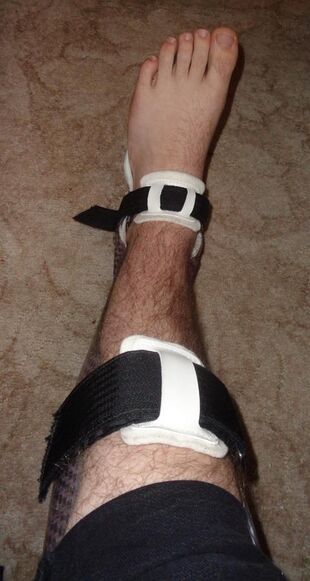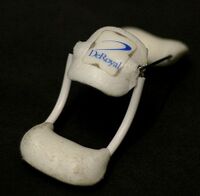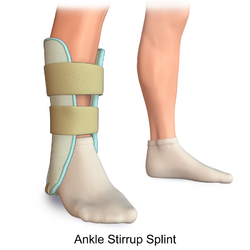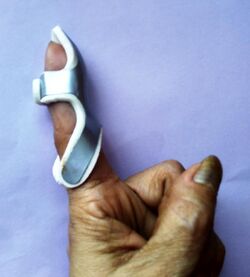Splint
Topic: Medicine
 From HandWiki - Reading time: 4 min
From HandWiki - Reading time: 4 min
| Splint | |
|---|---|
 An ankle foot orthosis (AFO), a type of splint used to support the foot and ankle. | |
| Specialty | Orthopedics |
A splint is defined as "a rigid or flexible device that maintains in position a displaced or movable part; also used to keep in place and protect an injured part" or as "a rigid or flexible material used to protect, immobilize, or restrict motion in a part".[1] Splints can be used for injuries that are not severe enough to immobilize the entire injured structure of the body. For instance, a splint can be used for certain fractures, soft tissue sprains, tendon injuries, or injuries awaiting orthopedic treatment. A splint may be static, not allowing motion, or dynamic, allowing controlled motion. Splints can also be used to relieve pain in damaged joints. Splints are quick and easy to apply and do not require a plastering technique. Splints are often made out of some kind of flexible material and a firm pole-like structure for stability. They often buckle or Velcro together.
Uses
- By the emergency medical services or by volunteer first responders, to temporarily immobilize a fractured limb before transportation;
- By allied health professionals such as occupational therapists, physiotherapists and orthotists, to immobilize an articulation (e.g. the knee) that can be freed while not standing (e.g. during sleep);
- By athletic trainers to immobilize an injured bone or joint to facilitate safer transportation of the injured person; or
- By emergency department (ED) physicians to stabilize fractures or sprains until follow-up appointment with an orthopedist.
Types
- Ankle stirrup – Used for the ankles.[2]
- Finger splints – Used for the fingers. A "mallet" or baseball finger is a rupture of the extensor tendon and sometimes including a fracture. While surgery may be necessary such an injury may heal if placed in a finger splint.[3]
- Nasal splint[4]
- Posterior lower leg
- Posterior full leg
- Posterior elbow
- Sugar tong – Used for the forearm or wrist. They are named "sugar-tong" due to their long, U-shaped characteristics, similar to a type of utensil used to pick up sugar cubes.[5]
- Thumb spica – Used for the thumb.[6]
- Ulnar gutter – Used for the forearm to the palm.[7]
- Volar wrist splint – Used for the wrist.[8]
- Wrist/arm splint – Used for the wrist or arm.
History
B.C. to A.D.
Splinting has been used since ancient times. Evidence suggests that splint usage dates back to 1500 B.C. that could treat not only fractures but burns as well.[citation needed] These splints were made from materials like, "leaves, reeds, bamboo, and bark padded with linen … [and] copper." Mummies from Egypt have been uncovered wearing splints from previous injuries that were obtained in their lifetime. Hippocrates, alive from 460 to 377 B.C., was very well known for his discoveries and techniques for splinting. He created a "distraction splint" that was advanced for his time. The splint, made up of leather cuffs that were separated by slim wooden slats, worked to repair the fracture and realign the bones. Around 1000 A.D. the use of Hippocrates' splinting technique using plants, like palm branches and cane halves, continued to be practiced. Flour dust, egg whites, and vegetable mixtures were created to form plaster for creating splints. Most splints in ancient times were cast-like and made to immobilize an area of the body. This is illustrated by the Aztecs around 1400 A.D. They made splints with leaves, leather, and paste.[9]
1500s
In the early 1500s gunpowder was introduced to Europe which caused a serious decline in the market of armor making. Armor makers had to figure out how to make a living with the skills they had already acquired. This led to the creation of braces due to the common use of metal in braces. Armor makers were knowledgeable in areas of the exterior anatomy and joint alignment, making braces the obvious replacement for their armor making. In 1517, after the evolution of the armor trade, injuries were being treated by metal braces secured by screws. Jumping to 1592, the first written piece on splints by surgeon Hieronymus Fabricius, shows various drawings of armor-like splints for the entire body.[9]
1700s–1800s
In the mid-1700s, doctors and mechanics worked with each other to create splints for certain injuries. Surgeons need these mechanics to design and build the splints for them. Most splints were made of metal. Plaster of Paris, a white powdery substance used mostly for casts and molds in the form of a quick-setting paste with water, began to be used for immobilizing splints.[10] This method was not a popular way of splinting as it took too long to dry and suitable fabric was sparse.
In the 1800s it was beginning to be recognized that rehabilitation after an injury was important. Orthopedics started to become a separate field from general surgery. A famous British Surgeon, Hugh Owen Thomas, created specialty splints that were cheap and best for injuries that were being rehabilitated. By 1883, mechanics and surgeons separated due to class issues. This created two different areas that shaped the way braces were being created and distributed. Around 1888, F. Gustav Ernst, a dedicated mechanic, released a book illustrating upper body splints. In 1899, orthopedic surgeon Alessandro Codivilla followed suit and published a book explaining the importance of using surgical procedures to set up better results using splints.[9]
See also
- SAM splint
- Traction splint
- Vacuum splint
- Cervical collar
- Kendrick extrication device
- Long spine board
- Orthopedic surgery
- Buddy wrapping
- PASG (Pneumatic Anti-Shock Garment)
References
- ↑ "The Glossary of Prosthodontic Terms Seventh Edition (GPT-7)". The Journal of Prosthetic Dentistry 81 (1): 48–110. January 1999. doi:10.1016/s0022-3913(99)70234-9. ISSN 0022-3913.
- ↑ Stirrup braces – Retrieved 22 October 2017
- ↑ OrthoInfo: Mallet Finger (Baseball Finger) – Retrieved 23 October 2017
- ↑ Summit Medical: Nasal Splints and Stents – Retrieved 22 October 2017
- ↑ Medscape: Sugar-Tong Forearm Splinting – Retrieved 22 October 2017
- ↑ Letmedco: The Thumb Spica Splint and its Uses- Retrieved 22 October 2017
- ↑ Ulnar Gutter Wrist Splint – Retrieved 22 October 2017
- ↑ Medscape: Volar Splinting – Retrieved 22 October 2017
- ↑ 9.0 9.1 9.2 Fess, Elaine Ewing (April 2002). "A History of splinting: To understand the present, view the past". Journal of Hand Therapy 15 (2): 97–132. doi:10.1053/hanthe.2002.v15.0150091. ISSN 0894-1130. PMID 12086034.
- ↑ "Definition of PLASTER OF PARIS". https://www.merriam-webster.com/dictionary/plaster+of+paris.
External links
 KSF
KSF


